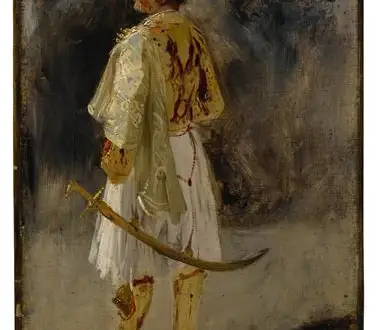Title of Artwork: “The Count of Palatino in the costume of a Palikar”

Artwork by Richard Parkes Bonington
Year Created 1825-1826
Summary of The Count of Palatino in the costume of a Palikar
If you believe the family, Demetrius de Palatiano was a bad child. He lived in Corfu from 1794 to 1849. It’s said that while working for the Ottoman ruler, Ali Pasha, he almost died by being beheaded. In family records, he’s said to have been unstable and prone to fleeing.
All About The Count of Palatino in the costume of a Palikar by Richard Parkes Bonington
It was a long time ago, but he had been to Albania, the Ionian islands, Italy, Germany, and England. Maximilian, the King of Bavaria, is said to have been on good terms with him. He wrote to his sister to say that he had been given the title of “Count” by Maximilian. Demetrius used the title freely in official documents, calling himself the “Honourable Count Demetrius de Palatiano.”
Research in the Commonwealth and Bavaria archives hasn’t been able to confirm this. On his way to Corfu from England in late 1825, he passed through Paris, where he posed for Delacroix’s painting of the Count Demetrius de Palatiano in Suliot Costume, which he did for free (c.1825-1827).
In the winter of 1825-1816, Bonington worked in Delacroix’s studio. He was inspired by Delacroix and turned to painting the genre and history of the day. It was a close-knit group of artists who shared models and compositions, emphasised colour, and worked together. When Delacroix and Bonington sketched the portraits of Count Demetrius Palikar, they both used the same subject matter and used the same style.
This is the uniform of a Suliot: a long white skirt (or foustanella), a gold-worked cloak, velvet gold-laced jacket, and a waistcoat. Silver-mounted pistols and daggers are also on the belt of Demetius. Ali Pasha took over Jannina in 1822, where the Suliots were forced to flee. They later fought bravely for Greece’s independence.
Other European countries were very interested in this war. The exotic clothes of Greek soldiers, known as Suliots or Palikari, were a favourite subject for artists. Even though Delacroix and Bonington may have been drawn to the Count de Palatiano’s costume because of the way it looked, his colourful and extravagant personality must have also attracted them.
This was a time when the memory of Byron was very important to French Romantic art. Byron wore the clothes of a Palikar when he was photographed by Thomas Philips. Before he arrived in Missolonghi in 1824, he hired a number of them to be his private guard, so they could protect him. It was said that Childe Harold’s Pilgrimage made the Suliots look like modern primitives, people who had not been changed by modern society.
He stands with his back to the person who is looking at the picture. They make a strong contrast with his dress, which has bright golden hues painted on it in a way that looks like it was done by accident. This makes the count look even more bold and flamboyant.
Information Citations
En.wikipedia.org, https://en.wikipedia.org/.























